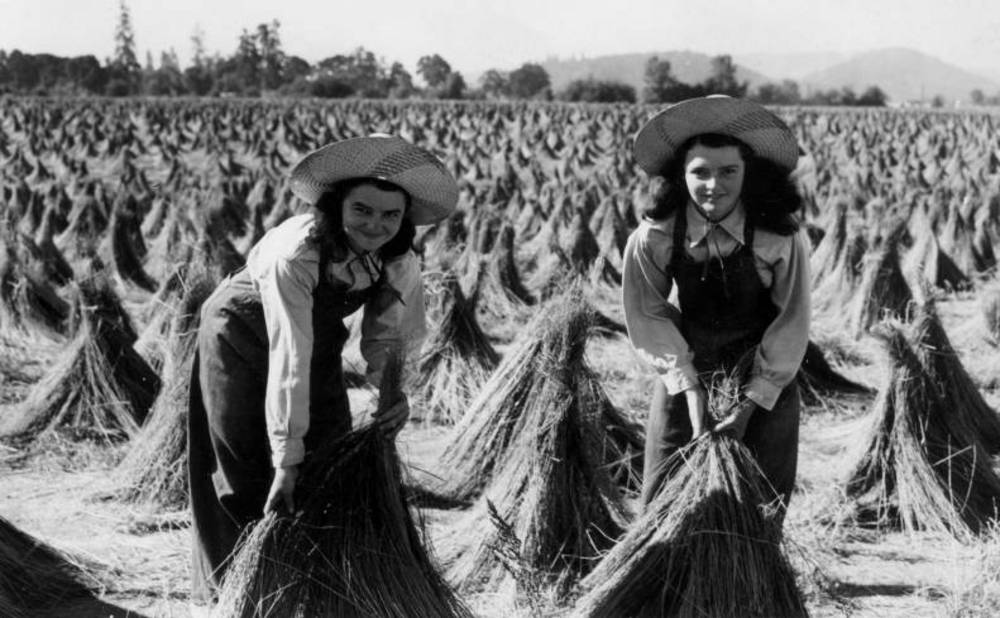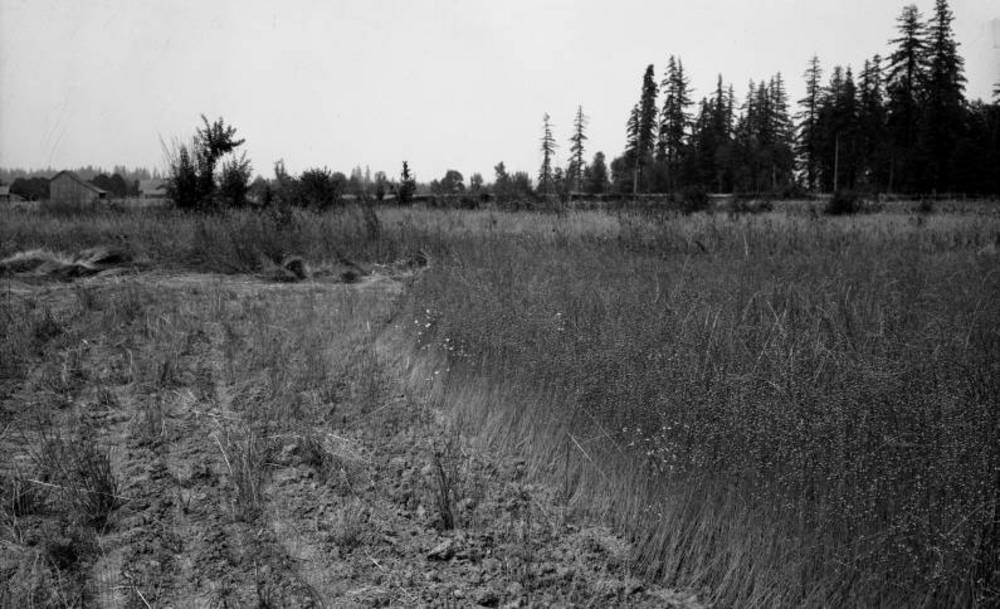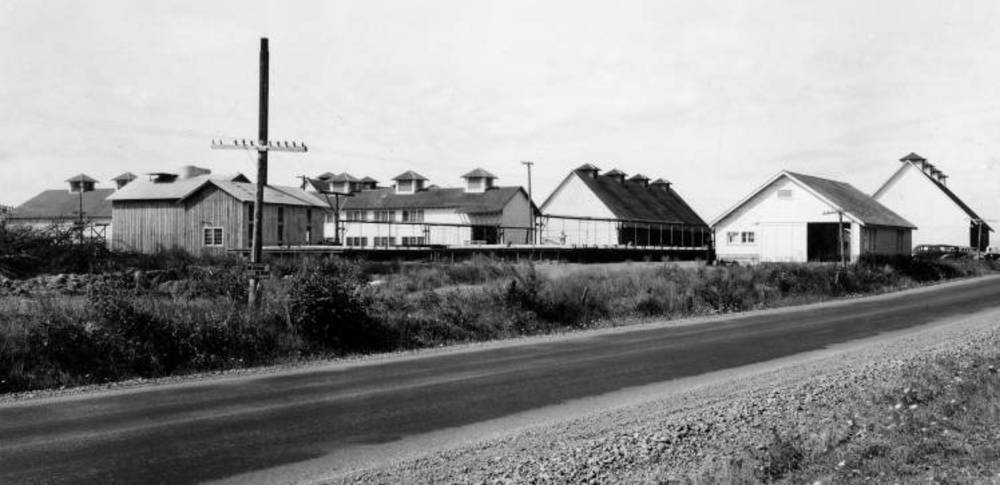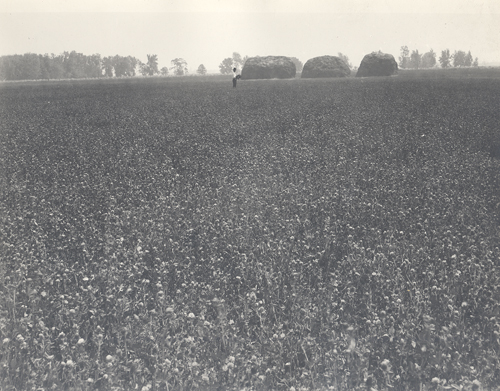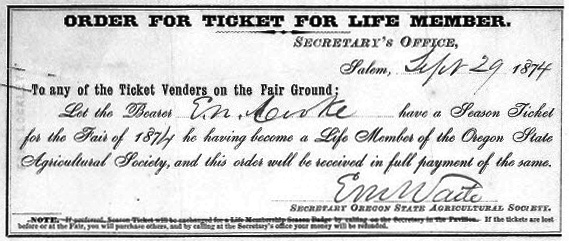From the mid-1840s until the 1950s, fields of blue-flowering flax flourished in the fertile Willamette Valley to support the only flax industry in the United States. The soil and climate were perfect for growing superior flax, and the plants were transformed into lustrous linen yarn and fabrics.
Several species of wild flax are native to Oregon, and when Meriwether Lewis and William Clark traveled down the Columbia River in 1805, they recorded descriptions of Indians fishing and making baskets using a twine made of wild flax. The Wasco, Klickitat, Warm Springs, Cayuse, Umatilla, and other tribes made bags of flax fiber.
The state's flax industry has its origins in seed that white settlers brought with them to Oregon. Sarah Damon Owen, for example, planted her seeds in the spring of 1844 and wrote that she "gathered a quart of seed, had enough fiber floss to pad two quilts, and a hank of the finest fiber ever seen." That same year, near Salem, Oregon pioneer Mary Matheny planted the seeds she brought West in her "treasure bag" and found the fiber "longer and of finer quality than that grown in Kentucky."
The first commercial flax venture was in 1867, when the Pioneer Oil Works processed locally grown flax for linseed oil, oil cakes for cattle feed, and yarn for upholstery fabrics. A small fiber-flax plant in Albany produced Oregon linen that won a prize at the Centennial Exposition of 1876 for its superior qualities. A flax spinning mill was built in Albany the next year to manufacture salmon net, twine, and shoelaces. A similar mill was constructed in Scio in 1890.
In the 1890s, Juliet Montague Lord, wife of Governor William Lord (1895-1899), became known as the "Flax Mother of Oregon" for her advocacy of the industry. Oregon flax won a prize at the 1893 Chicago World's Fair in the display planned by Lord. She also organized the Oregon Women's Flax Fiber Association to promote the industry. The enthusiastic group incorporated and sold stock to aid farmers willing to grow the crop.
In 1915, Oregon State Penitentiary inmates were employed to process flax. Even with such inexpensive labor, however, the cultivation and harvesting of flax was rarely profitable. Foreign competition was fierce, and frequent fires in the combustible flax fiber storage barns ravaged many early efforts. Farmers and mill owners also faced hurdles from the government; legislation allowing states to ban prison-made goods and price supports were granted and later revoked.
Oregon's flax and linen production peaked during World War II—with 18,000 acres of flax and 14 processing plants—when it was designated an "essential war product." There were annual flax festivals, displays at the state fair, and the production of yarns, fabric for upholstery and draperies, braided rugs, fish net, and shoelaces. No part of the flax plant was wasted, with seeds and shives—the bits of woody core stripped from fiber—used for replanting, oil, fuel, fiberboard, linoleum, and cattle feed.
The USDA sent engineer Jesse E. Harmond to Oregon in 1945 to assist the flax industry. He designed machinery to expedite processing and formed a small company called Oregon Custom Weavers to make linen fabric and fabric-covered products.
In spite of all efforts, the labor-intensive flax industry could not survive when the government removed subsidies after World War II and new and flashier synthetic fibers were introducted. The last plant in Oregon—located near Canby and considered the most modern of its kind—was closed in the 1960s. Handweavers are still creating heirloom textiles with the last of their treasured supply of Oregon linen yarn.
-
![Mabel and Jessie Blackwell "wigwaming" fibre flax at the Benton County Flax Growers Cooperative near Monroe, 1944.]()
Wigwaming flax, Benton County.
Mabel and Jessie Blackwell "wigwaming" fibre flax at the Benton County Flax Growers Cooperative near Monroe, 1944. Oreg. State Univ. Archives, Extension and Exp. Sta. Comm., P120:2816
-
![Flax field at Lester Burley farm, Canby.]()
Flax field, Canby.
Flax field at Lester Burley farm, Canby. Oreg. State Univ. Archives, Bioresource Eng. Dept. Photo. Coll., P106:FX 52-8-39
-
![Benton County Flax Mill, Sept. 1943.]()
Benton County flax mill, 1943.
Benton County Flax Mill, Sept. 1943. Oreg. State Univ. Archives, SG 3 FX203-9-43
Related Entries
-
![Grass seed industry]()
Grass seed industry
The Willamette Valley, with its temperate climate, wet winters, and ari…
-
![Oregon State Agricultural Society]()
Oregon State Agricultural Society
On February 22 and 23, 1860, delegates from nine Oregon county agricult…
Map This on the Oregon History WayFinder
The Oregon History Wayfinder is an interactive map that identifies significant places, people, and events in Oregon history.
Further Reading
Hoskins, Nancy. “Oregon Flax and Linen.” Handwoven (March/April 1997): 63.
Wyatt, Steve M. "Flax and Linen: An Uncertain Oregon Industry." Oregon Historical Quarterly 95:22 (1994), 150-175.



